Kyoto (Western)
Arashiyama and Sagano
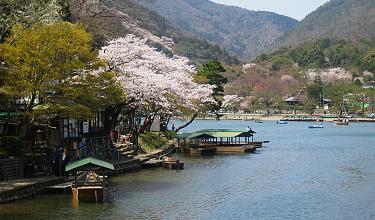
Arashiyama is a pleasant, touristy district at the outskirts of Kyoto. Its landmark is the wooden (now partially concrete) Togetsukyo Bridge with forested Mount Arashiyama as backdrop.
There are many things to see and do in the Arashiyama area. Tenryuji, a leading Zen temple, shops, cafes and restaurants are found in the district's busy center around Togetsukyo Bridge and Keifuku Arashiyama Station.
North of the central area, there are bamboo groves and a residential district with several small temples, scattered along the base of the wooded mountains. The area with its rural feel is best explored on foot, by rental bicycle (around 700 Yen per day) or on a rickshaw (around 8000 Yen for 30 minutes and 2 persons).
Another pleasant thing to do is taking a two hour boat tour down Hozu River. The river flows through an idyllic, forested valley before reaching urban Kyoto at the Togetsukyo Bridge. Alternatively, you can enjoy views of the valley from the Sagano Romantic Train.
Arashiyama is particularly beautiful and busy during the cherry blossom and autumn leaf seasons.
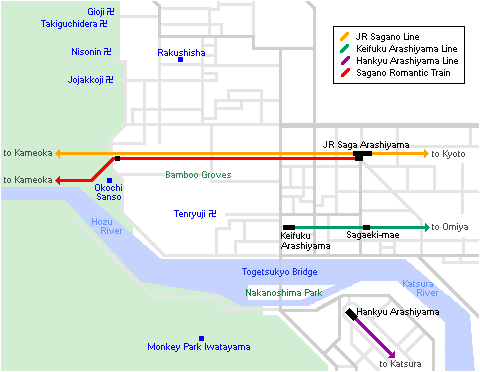
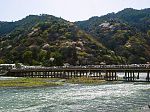 | Togetsukyo Bridge |
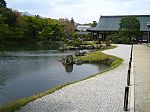 | Tenryuji Temple |
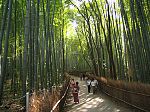 | Bamboo Groves |
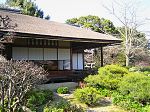 | Okochi Sanso |
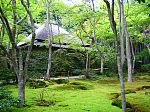 | Small Temples |
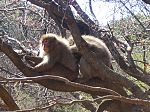 | Monkey Park Iwatayama |
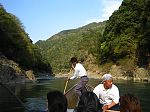 | Hozu River Boat Tours |
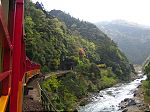 | Sagano Romantic Train |
By Japan Railways (JR)
The fastest access from Kyoto Station to Arashiyama is provided by the JR Sagano Line (also known as JR Sanin Line). The one way ride from Kyoto Station to Saga-Arashiyama Station takes 15 minutes and costs 230 Yen.
From Saga-Arashiyama Station, central Arashiyama can be reached in a 5-10 minute walk.
By Keifuku Railways
The small trains on the Keifuku Arashiyama Line connect Arashiyama with Omiya Station in central Kyoto (20 minutes, 200 Yen). Omiya Station is located at the intersection of Shijo Street and Omiya Street.
Keifuku Railways also provides access to Kitanohakubaicho Station in northern Kyoto, not far from Kinkakuji, Ryoanji and Ninnaji Temples (20-30 minutes, 200 Yen). One transfer of trains is required along the way.
Keifuku Arashiyama Station is located in the very center of Arashiyama.
By Hankyu Railways
From Kawaramachi or Karasuma Station in central Kyoto (Shijo Street), take the Hankyu Main Line to Katsura Station and transfer to the Hankyu Arashiyama Line for Arashiyama. The one way trip takes about 20 minutes and costs 220 Yen.
Hankyu Arashiyama Station is located on the opposite side of the river, about a 5-10 minute walk from central Arashiyama.
By Bus
Bus lines connect Arashiyama with several parts of Kyoto, however, it is recommended to access Arashiyama by train to avoid the risk of getting stuck in traffic jams.
Tenryuji
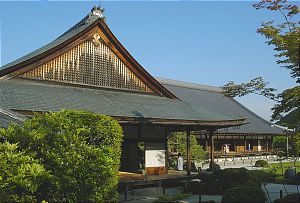
Tenryuji is a Zen temple in the Arashiyama area of Kyoto. It has been ranked first among the city's "Five Great Zen Temples".
The temple was established in 1339, and like many other temples burnt down several times over its history. The current buildings date from the Meiji Period. Muso Soseki, the temple's founding abbot and famous garden designer, created Tenryuji's landscape garden which, unlike the temple buildings, survived the many fires and is considered one of the oldest of its kind.
Tenryuji has been designated a UNESCO world heritage site in 1995.
Tenryuji is just a few steps from the Keifuku Arashiyama terminal station. The small Keifuku trains connect Arashiyama with the Ryoanji/Kinkakuji area and Shijo-dori.
The JR Saga-Arashiyama Station is a 5 minute walk from Tenryuji and is served by the JR Sagano Line (San-in Line) with frequent trains that take about 15 minutes to Kyoto Station.
Katsura Imperial Villa
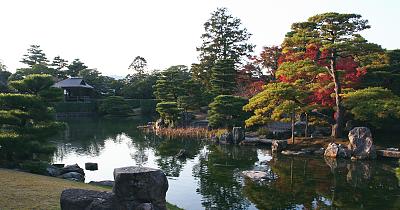
Katsura Imperial Villa (Katsura Rikyu) is one of the finest examples of purely Japanese architecture and garden design. The villa and garden in their present form were completed in 1645 as the residence for the Katsura Family, members of Japan's Imperial Family.
The villa can be viewed only on tours held by the Imperial Household Agency. Several tours are held daily on weekdays and on some Saturdays. They last about one hour and are in Japanese only.
The actual villa is located in western Kyoto. From the Imperial Palace or Kyoto Station, take the Karasuma Subway Line to Shijo Station and transfer to the Hankyu Kyoto Line to Katsura Station. From the station, it is a 15 minute walk to the villa.
From Kyoto Station, there is also a direct bus number 33 to the villa. Get off at Katsura Rikyu-mae, from where it is a 5 minute walk.